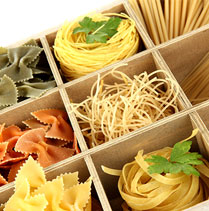
One of the most challenging things for kids and their parents to endure is a wheat allergy or gluten intolerance, so we have some basics to help you out!
Wheat and gluten are in many kid-friendly foods, including bread, crackers, cookies, pastas, cereals, and candies. Avoiding wheat can be especially difficult in the United States since it is the nation’s predominant grain of choice. But, have no fear! If your child has an allergy to wheat or is intolerant to gluten, there are a lot of foods he can enjoy and plenty of ways for you to help compensate for his food restrictions!
Are wheat allergy and gluten intolerance the same thing?
Wheat allergy and gluten intolerance are two different but related issues. When a child has an allergy to wheat, he or she has an allergic reaction to one of the proteins in wheat. Allergic symptoms can range from mild (such as a skin rash or stomach ache) to severe (such as trouble breathing and the narrowing of airways). Kids with wheat allergy may also be allergic to other grains, such as barley, oat, and rye since they all contain similar proteins. A simple blood test can reveal which grains your child is allergic to. Wheat allergy is much more common in children than adults, but fortunately, most wheat-allergic children will outgrow this allergy. The only way to prevent getting the uncomfortable symptoms associated with wheat allergy is to stay away from all foods containing wheat.
What is Celiac disease?
Celiac disease is an intolerance to gluten, a protein commonly found in wheat, rye, and barley. Celiac Disease, also called Celiac Sprue or Gluten-Sensitive Enteropathy, is technically not an allergy, but an autoimmune disorder that can cause inflammation of the small intestine. People with Celiac Disease, or gluten intolerance, may experience diarrhea, abdominal pain, bloating, failure to gain weight, and poor nutrient absorption when he or she eats a food that contains gluten. Read more about Celiac Disease here.
Which foods contain gluten?
In addition to wheat, barley and rye, gluten can also be found in oats due to cross-contact since many brands of oats are processed on equipment that is shared with wheat, barley and rye. Some brands of oats are safe from cross-contamination, so careful label reading is very important for parents of children with gluten intolerance.
If you are trying to help your child avoid wheat and/or gluten, you must become a meticulous label-reader! Some sources of wheat proteins are obvious, such as bread, but all wheat proteins — and gluten in particular — may be used in a number of prepared and processed foods.
Foods and products that MAY contain wheat proteins include:
- Breads
- Cakes and muffins
- Breakfast cereals
- Pasta
- Couscous
- Crackers
- Beer (for gluten-intolerant moms and dads)
- Hydrolyzed vegetable protein
- Soy sauce
- Condiments, such as ketchup
- Meat, crab or shrimp substitutes
- Coffee substitutes
- Meat products, such as hot dogs, meatballs and turkey patties
- Dairy products, such as ice cream
- Natural flavorings
- Gelatinized starch
- Modified food starch
- Vegetable gum
- Playdough (be extra careful not to allow your child to put near their mouth)
- Potato chips
- Breading on fried foods, such as chicken tenders
If you or your child is allergic to wheat or is gluten intolerant, try the following gluten and wheat free substitutions:
- Pastas made with quinoa flour, brown rice flour, or corn flour
- Gluten-free cereals, such as Rice Chex® or Corn Chex®
- Gluten-free muffin, brownie, and cake mixes. These products substitute brown rice flour, tapioca flour, and/or arrowroot flour for wheat flour.
- When baking with wheat-free flours, a combination of flours usually works best. One cup of wheat flour can be replaced with any of these options:
-
- 7/8 cup rice flour,
- 5/8 cup potato starch flour,
- 1 cup soy flour plus ¼ cup potato starch flour, or
- 1 cup corn flour
Be sure to remember these tips when raising a child with food allergies:
- To help prevent your child from feeling a sense of deprivation, keep lots of wheat/ gluten alternatives in the house, such as corn crackers, rice cereals, quinoa pasta, and gluten-free cookies and snacks. Be sure to pack lots of gluten-free fun snacks in your child’s lunchbox so he or she is not feeling disadvantaged at the lunch table in school.
- Be sure to enjoy gluten-free baking with your child. Cooking together in the kitchen is a fun learning experience that you can take pleasure in together. Use the baking substitutions mentioned above or buy ready-prepared baking mixes that are labeled “gluten-free”.
- Don’t make your child feel isolated by being the only one that has to eat differently. Enjoy a grilled cheese sandwich made with gluten-free bread with your child and make brown rice pasta for the whole family to eat.
- Make sure that your child is getting the proper nutrition that he would be getting had he not been on a wheat/gluten restriction. Make sure he is getting plenty of complex carbohydrates, such as rice, potatoes, and corn on a daily basis.











